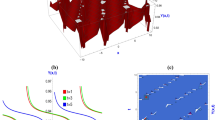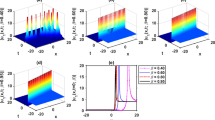Abstract
We explore the Whitham modulation theory and one of its physical applications, the dam-breaking problem for the defocusing Hirota equation that describes the propagation of ultrashort pulses in optical fibers with third-order dispersion and self-steepening higher-order effects. By using the finite-gap integration approach, we deduce periodic solutions of the equation and discuss the degeneration of genus-one periodic solution to a soliton solution. Furthermore, the corresponding Whitham equations based on Riemann invariants are obtained, which can be used to modulate the periodic solutions with step-like initial data. These Whitham equations with the weak dispersion limit are quasilinear hyperbolic equations and elucidate the averaged dynamics of the fast oscillations referred to as dispersive shocks, which occur in the solution of the defocusing Hirota equation. We analyze the case where both characteristic velocities in genus-zero Whitham equations are equal to zero and the values of two Riemann invariants are taken as the critical case. Then by varying these two values as step-like initial data, we study the rarefaction wave and dispersive shock wave solutions of the Whitham equations. Under certain step-like initial data, the point where two genus-one dispersive shock waves begin to collide at a certain time, that is, the point where the genus-two dispersive shock wave appears, is investigated. We also discuss the dam-breaking problem as an important physical application of the Whitham modulation theory.












Similar content being viewed by others
References
P. K. Shukla and B. Eliasson, “Nonlinear aspects of quantum plasma physics,” Phys. Usp., 53, 51–76 (2010).
F. Dalfovo, S. Giorgini, L. P. Pitaevskii, and S. Stringari, “Theory of Bose–Einstein condensation in trapped gases,” Rev. Mod. Phys., 71, 463–512 (1999).
F. Smirnov, Form Factors in Completely Integrable Models of Quantum Field Theory (Advanced Series in Mathematical Physics, Vol. 14), World Sci., Singapore (1992).
R. Hirota, “Exact envelope-soliton solutions of a nonlinear wave equation,” J. Math. Phys., 14, 805–809 (1973).
W. Xun, L. Ju, and E. Fan, “Painlevé-type asymptotics for the defocusing Hirota equation in transition region,” Proc. Roy. Soc. A, 478, 20220401, 14 pp. (2022).
A. Ankiewicz, J. M. Soto-Crespo, and N. Akhmediev, “Rogue waves and rational solutions of the Hirota equation,” Phys. Rev. E, 81, 046602, 8 pp. (2010).
F. Demontis, G. Ortenzi, and C. van der Mee, “Exact solutions of the Hirota equation and vortex filaments motion,” Phys. D., 313, 61–80 (2015).
J. Cen and A. Fring, “Asymptotic and scattering behaviour for degenerate multi-solitons in the Hirota equation,” Phys. D., 397, 17–24 (2019).
J. Chen and R. Tong, “The complex Hamiltonian systems and quasi-periodic solutions in the Hirota equation,” J. Nonlinear Math. Phys., 28, 134–149 (2021).
Z.-Y. Zhang, “Jacobi elliptic function expansion method for the modified Korteweg– de Vries–Zakharov–Kuznetsov and the Hirota equations,” Rom. J. Phys., 60, 1384–1394 (2015).
W.-Q. Peng, S.-F. Tian, X.-B. Wang, and T.-T. Zhang, “Characteristics of rogue waves on a periodic background for the Hirota equation,” Wave Motion, 93, 102454, 10 pp. (2020).
X. Gao and H.-Q. Zhang, “Rogue waves for the Hirota equation on the Jacobi elliptic cn-function background,” Nonlinear Dyn., 101, 1159–1168 (2020).
A. M. Kamchatnov, “On improving the effectiveness of periodic solutions of the NLS and DNLS equations,” J. Phys. A: Math. Gen., 23, 2945–2960 (1990).
A. M. Kamchatnov, “New approach to periodic solutions of integrable equations and nonlinear theory of modulational instability,” Phys. Rep., 286, 199–270 (1997).
H. Flashka, M. G. Forest, and D. W. McLaughlin, “Multiphase averaging and the inverse spectral soluions of the Korteweg–de Vries equation,” Commun. Pure Appl. Math., 33, 739–784 (1980).
A. M. Kamchatnov, “Whitham equations in the AKNS scheme,” Phys. Lett. A, 186, 387–390 (1994).
G. B. Whitham, “Non-linear dispersive waves,” Proc. Roy. Soc. London Ser. A, 283, 283–291 (1965).
G. B. Whitham, Linear and Non-Linear Waves, John Wiley and Sons, New York (1974).
G. A. El and M. A. Hoefer, “Dispersive shock waves and modulation theory,” Phys. D, 333, 11–65 (2016).
D.-S. Wang, L. Xu, and Z. Xuan, “The complete classification of solutions to the Riemann problem of the defocusing complex modified KdV equation,” J. Nonlinear Sci., 32, 3, 46 pp. (2022).
A. V. Gurevich and L. P. Pitaevskiĭ, “Nonstationary structure of a collisionless shock wave,” Sov. Phys. JETP, 38, 291–297 (1974).
Y. Kodama, V. U. Pierce, and F.-R. Tian, “On the Whitham equations for the defocusing complex modified KdV equation,” SIAM J. Math. Anal., 40, 1750–1782 (2008).
G. Biondini and Y. Kodama, “On the Whitham equations for the defocusing nonlinear Schrödinger equation with step initial data,” J. Nonlinear Sci., 16, 435–481 (2006).
Y. Zhang, H.-Q. Hao, and R. Guo, “Periodic solutions and Whitham modulation equations for the Lakshmanan–Porsezian–Daniel equation,” Phys. Lett. A, 450, 128369, 19 pp. (2022).
G. A. El, V. V. Geogjaev, A. V. Gurevich, and A. L. Krylov, “Decay of an initial discontinuity in the defocusing NLS hydrodynamics,” Phys. D, 87, 186–192 (1995).
Y. Kodama, “The Whitham equations for optical communications: mathematical theory of NRZ,” SIAM J. Appl. Math., 59, 2162–2192 (1999).
L. Li, Z. H. Li, Z. Y. Xu, G. S. Zhou, and K. H. Spatschek, “Gray optical dips in the subpicosecond regime,” Phys. Rev. E, 66, 046616, 8 pp. (2002).
A. Mahalingam and K. Porsezian, “Propagation of dark solitons with higher-order effects in optical fibers,” Phys. Rev. E, 64, 046608, 9 pp. (2001).
Acknowledgments
We sincerely thank Professor Yuji Kodama for the valuable suggestions.
Funding
The work was supported by the “Jingying” project of Shandong University of Science and Technology.
Author information
Authors and Affiliations
Corresponding author
Ethics declarations
The authors of this work declare that they have no conflicts of interest.
Additional information
Prepared from an English manuscript submitted by the author; for the Russian version, see Teoreticheskaya i Matematicheskaya Fizika, 2024, Vol. 218, pp. 449–474 https://doi.org/10.4213/tmf10592.
Publisher’s note. Pleiades Publishing remains neutral with regard to jurisdictional claims in published maps and institutional affiliations.
Rights and permissions
About this article
Cite this article
Li, X., Bai, Q. & Zhao, Q. Whitham modulation theory and dam-breaking problem under periodic solutions to the defocusing Hirota equation. Theor Math Phys 218, 388–410 (2024). https://doi.org/10.1134/S0040577924030036
Received:
Revised:
Accepted:
Published:
Issue Date:
DOI: https://doi.org/10.1134/S0040577924030036




